一生要去的50个地方之Chichen Itza, Mexico
最新整理高中英语Ins上最受欢迎的全球50个地标景点(双语对照).docx

最新整理高中英语Ins上最受欢迎的全球50个地标景点(双语对照)1.EiffelTower,Paris-#EiffelTower埃菲尔铁塔,巴黎2.BigBen,London-#BigBen大本钟,伦敦3.GrandCanyon1,USA-#GrandCanyon大峡谷,美国4.LondonEye,London-#LondonEye伦敦眼,伦敦5.EmpireStateBuilding,USA-#EmpireStateBuilding帝国大厦,美国6.GoldenGateBridge,USA-#GoldenGateBridge金门大桥,美国7.TowerBridge,London-#TowerBridge塔桥,伦敦8.StatueofLiberty,USA-#StatueofLiberty自由女神像,美国9.SagradaFamilia,Barcelona-#SagradaFamilia圣家族大教堂,巴塞罗那10.Colosseum,Rome-#Colosseum斗兽场,罗马Tower,Toronto,Canada-#CNTower西恩塔,多伦多12.MachuPicchu,Peru-#MachuPicchu马丘比丘,秘鲁13.BurjAlArab,Dubai-#BurjAlArab帆船酒店,迪拜14.TajMahal,Agra,India-#TajMahal泰姬陵,印度阿格拉15.BuckinghamPalace,London-#BuckinghamPalace白金汉宫,伦敦16.ArcdeTriomphe,Paris-#ArcDeTriomphe凯旋门,巴黎17.SydneyOperaHouse,Sydney-#SydneyOperaHouse悉尼歌剧院,悉尼18.Sacre-Coeur,Paris-#SacreCoeur圣心大教堂,巴黎19.Stonehenge,England-#Stonehenge巨石阵,英国20.ChichenItza,Mexico-#ChichenItza奇琴伊察古城遗址,墨西哥21.Hollywoodsign,LosAngeles-#HollywoodSign好莱坞标志牌,洛杉矶22.GreatWallofChina,Beijing-#GreatWall中国万里长城,北京23.WillisTower,Chicago-#WillisTower希尔斯大厦,芝加哥24.TreviFountain,Rome-#TreviFountain特莱维喷泉,罗马25.GoldenTemple,Punjab,India-#GoldenTemple金庙,印度旁遮普26.Uluru,Petermann-#Uluru乌卢鲁巨石,彼得曼27.HagiaSophia,Istanbul-#HagiaSophia圣索菲亚大教堂,伊斯坦布尔28.MountFuji,Fujinomiya-#MountFuji富士山,富士宫市29.NeuschwansteinCastle,Germany-#Neuschwanstein新天鹅城堡,德国30.LochNess,Scotland-#LochNess尼斯湖,苏格兰31.MontSaint-Michel,France-#MontSaintMichel圣米歇尔山,法国32.ForbiddenCity,Beijing-#ForbiddenCity紫禁城,北京33.LeaningTowerofPisa,Italy-#LeaningTowerOfPisa比萨斜塔,意大利34.St.Peter'sBasilica,VaticanCity-#StPetersBasilica圣彼得大教堂,梵蒂冈城35.BrandenburgGate,Berlin-#BrandenburgGate勃兰登堡门,柏林36.MannekenPis,Brussels-#MannekenPis小于连撒尿雕像,布鲁塞尔37.Gateway2Arch,St.Louis,Missouri-#GatewayArch圣路易斯拱门,密苏里38.ChristtheRedeemer,Brazil-#ChristTheRedeemer里约热内卢基督像,巴西39.TheLouvre,Paris-#TheLouvre卢浮宫,巴黎40.PalaceofVersailles,Île-de-France-#PalaceofVersailles凡尔赛宫,巴黎41.SaintBasil'sCathedral,Moscow-#StBasilsCathedral圣巴西尔大教堂,莫斯科42.BranCastle,Romania-#BranCastle布兰城堡,罗马尼亚43.WhiteCliffsofDover,England-#WhiteCliffsOfDover多佛白崖,英国44.AngelFalls,Venezuela-#AngelFalls安赫尔瀑布,委内瑞拉45.MoscowKremlin,Moscow-#MoscowKremlin克里姆林宫,莫斯科46.PotalaPalace,Lhasa-#PotalaPalace布达拉宫,拉萨47.SultanAhmedMosque3,Istanbul-#SultanAhmedMosque蓝色清真寺,伊斯坦布尔48.GreatPyramidofGiza,Egypt-#GreatPyramid吉萨大金字塔,埃及49.ParkGuell,Barcelona-#ParkGuellBarcelona奎尔公园,巴塞罗那50.MountRushmoreNationalMemorial,SouthDakota-#MountRushmoreNation alMemorial拉什莫尔山国家纪念公园,南达科他州1canyonn.峡谷,溪谷参考例句:·TheGrandCanyonintheUSAis1900metresdeep.美国的大峡谷1900米深。
BBC评出的人生50个

14.瑞士策马特峰 Zermatt, Switzerland
策马特(Zermatt)是位于瓦莱斯州(Valais),海拔有162O公尺高,人口只有15000的小 城镇,同时也是是瑞士“冰河列车”的起终点。策马特虽小,但在国际上享有超然的地位, 紧贴着世界闻名的马特洪峰(Matterhorn),标高4478m的马特洪峰高耸于策马特镇,如钢 铁般的角锥形造型.
3.罗马 Rome, Italy
意大利首都罗马(Rome)是有着辉煌历史的欧洲文明古城,由于它建在7座山丘之上并 有悠久的历史,故被称为“七丘城”和“永恒之城”。罗马位于亚平宁半岛中部的台伯河 畔,总面积为1507.6平方公里。罗马被喻为全球最大的“露天历史博物馆”。
4.旧金山 San Francisco, USA
阿姆利则金庙又称哈曼迪尔寺,是印度锡克教的最大一个寺庙,位于印度边境城市阿 姆利则市中心。整座金庙的建造共耗费750公斤黄金。这座被誉为“锡克教圣冠上的宝石” 的建筑,风格典雅,造型优美,既有伊斯兰教建筑的肃穆庄重,又有印度教建筑的绚丽璀 璨。它是锡克教的最重要圣地,每日朝圣者络绎不绝。
17.好望角 Cape Town, South Africa
18.南岛 South Island, New Zealand
南岛是组成新西兰的主要两个海岛之一,与北岛被库克海峡隔断。 毛利人名字对于南岛是 “Te Wai Pounamu” 就是手段“绿玉水” 的意思。
19.美国佛罗里达州奥兰多迪斯尼乐园 Florida, USA
世界度假区面积近40平方里,提供世界首屈一指的娱乐体验,拥有四个主题乐园(神奇王 国(Magic Kingdom)、艾波卡特(Epcot)、迪士尼好莱坞影城(Disney's Hollywood Studios)及迪士尼动物王国(Disney's Animal Kingdom)、两个水上主题 公园: 暴风滩(Blizzard Beach)及台风湖(Typhoon Lagoon)
【国家地理杂志】世界上50个人生必去之地

【国家地理杂志】世界上50个人生必去之地美国国家地理评选的世界上50个人生必去之地,共分5类:名城、蛮荒之地、人间天堂、漫无疆界的原野、世界奇观。
城市风情(不朽之城):1.New York 纽约(美国)2.Istanbul 伊斯坦布尔(土耳其)3.Barcelona 巴塞罗那(西班牙)4.Hong Kong 香港(中国)5.里约热内卢Rio de Janeiro (巴西)6.Paris 巴黎(法国)7.耶路撒冷Jerusalem (以色列/巴勒斯坦)8.伦敦London (英国)9.威尼斯Venis (意大利)10.旧金山San Francisco (美国)野外探险(最后的伊甸园):11.坦桑尼亚塞伦盖蒂平原Serengeti12.加拿大落基山脉Canadian Rockies13.澳大利亚内陆Australian Outback14.巴布亚新几内亚珊瑚礁Papua New Guinea Coral Reefs15.亚马逊森林Amazon (巴西、秘鲁、哥伦比亚、玻利维亚、委内瑞拉、厄瓜多尔、圭亚那、苏里南)16.美国科罗拉多大峡谷Grand Canyon17.厄瓜多尔加拉帕古斯群岛Galapagos18.委内瑞拉蒂普斯高原的平顶山区Venezuela's Tepuis19.北非撒哈拉大沙漠Sahara20.南极Antarctica人间天堂(美丽、平静、天堂般愉悦)21.帕劳太平洋诸岛Pacific Islands22.美国明尼苏达州的边界水域Boundary Waters23.传统日式旅馆Japanese Ryokan24.希腊小岛Greek Islands25.塞舌尔群岛Seychelles26.智利托雷德裴恩国家公园Torres del Paine27.英属维京群島British Virgin Islands28.意大利阿玛尔菲海岸Amalfi Coast29.印度喀拉拉邦Kerala30.美国夏威夷群岛Hawaiian Islands阳光地带(现代文明与自然的完美结合):31.英格兰湖区England's Lake District32.新西兰北岛North Island,New Zealand33. 法国卢瓦尔河谷Loire Valley34.美国加利福尼亚州大苏尔Big Sur35.加拿大滨海诸省Canadian Maritimes36.美国佛蒙特Vermont37.挪威海岸Coastal Norway38.越南岘港至顺化一带Danang to Hue39.阿尔卑斯山Alps40.意大利托斯卡纳区Tuscany世界奇观(人类不朽的创造):41.印度泰姬陵Tai Mahal42.美国科罗拉多州梅萨维德国家公园Mesa Verde43.梵蒂冈Vatican44.希腊雅典卫城Acropolis45.约旦佩特拉Petra46.秘鲁马丘比丘遗迹Machu Picchu47.中国长城The Great Wall48.柬埔寨吴哥窟Angkor49.埃及金字塔Giza Pyramids50.网络空间Cyberspace。
国家地理杂志评选的一生必去的50个地方
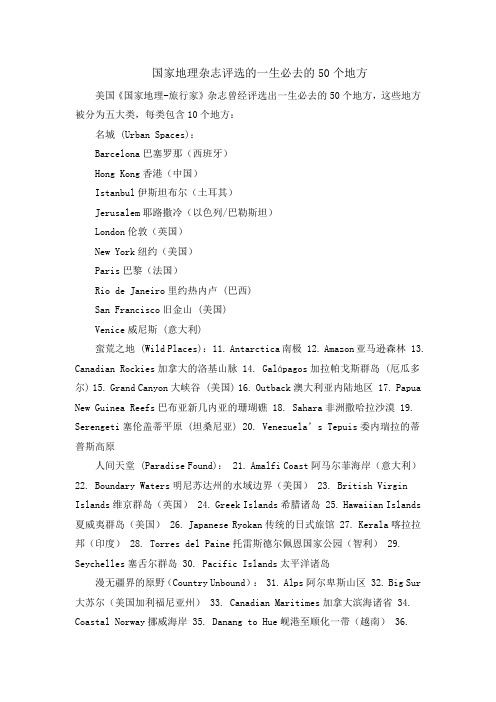
国家地理杂志评选的一生必去的50个地方美国《国家地理-旅行家》杂志曾经评选出一生必去的50个地方,这些地方被分为五大类,每类包含10个地方:名城 (Urban Spaces):Barcelona巴塞罗那(西班牙)Hong Kong香港(中国)Istanbul伊斯坦布尔(土耳其)Jerusalem耶路撒冷(以色列/巴勒斯坦)London伦敦(英国)New York纽约(美国)Paris巴黎(法国)Rio de Janeiro里约热内卢 (巴西)San Francisco旧金山 (美国)Venice威尼斯 (意大利)蛮荒之地 (Wild Places): 11. Antarctica南极 12. Amazon亚马逊森林 13. Canadian Rockies加拿大的洛基山脉 14. Galápagos加拉帕戈斯群岛 (厄瓜多尔) 15. Grand Canyon大峡谷 (美国) 16. Outback澳大利亚内陆地区 17. Papua New Guinea Reefs巴布亚新几内亚的珊瑚礁 18. Sahara非洲撒哈拉沙漠 19. Serengeti塞伦盖蒂平原 (坦桑尼亚) 20. Venezuela’s Tepuis委内瑞拉的蒂普斯高原人间天堂 (Paradise Found): 21. Amalfi Coast阿马尔菲海岸(意大利)22. Boundary Waters明尼苏达州的水域边界(美国) 23. British Virgin Islands维京群岛(英国) 24. Greek Islands希腊诸岛 25. Hawaiian Islands 夏威夷群岛(美国) 26. Japanese Ryokan传统的日式旅馆 27. Kerala喀拉拉邦(印度) 28. Torres del Paine托雷斯德尔佩恩国家公园(智利) 29. Seychelles塞舌尔群岛 30. Pacific Islands太平洋诸岛漫无疆界的原野(Country Unbound): 31. Alps阿尔卑斯山区 32. Big Sur 大苏尔(美国加利福尼亚州) 33. Canadian Maritimes加拿大滨海诸省 34. Coastal Norway挪威海岸 35. Danang to Hue岘港至顺化一带(越南) 36.England’s Lake District英格兰的湖泊地区 37. Loire Valley卢瓦尔河谷(法国) 38. North Island, New Zealand新西兰的北岛 39. Tuscany托斯卡纳区(意大利) 40. Vermont佛蒙特州(美国)世界奇观(World Wonders): 41. Acropolis雅典卫城 (希腊) 42. Angkor 吴哥窟(柬埔寨) 43. Giza Pyramids吉萨金字塔(埃及) 44. Great Wall 长城(中国) 45. Machu Picchu马丘比丘遗迹(秘鲁) 46. Mesa Verde梅萨维德国家公园 (美国科罗拉多州) 47. Petra皮特拉(约旦) 48. Taj Mahal 泰姬陵(印度) 49. Vatican City梵蒂冈城 50. Cyberspace网络空间。
国家地理杂志评选一生必去的50个地方列表
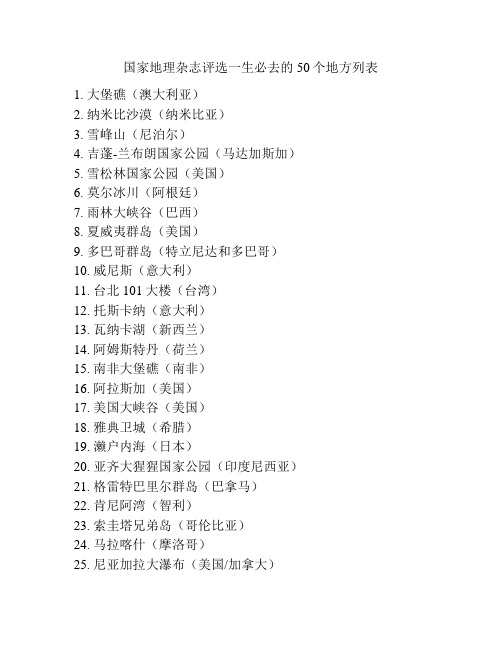
国家地理杂志评选一生必去的50个地方列表1. 大堡礁(澳大利亚)2. 纳米比沙漠(纳米比亚)3. 雪峰山(尼泊尔)4. 吉蓬-兰布朗国家公园(马达加斯加)5. 雪松林国家公园(美国)6. 莫尔冰川(阿根廷)7. 雨林大峡谷(巴西)8. 夏威夷群岛(美国)9. 多巴哥群岛(特立尼达和多巴哥)10. 威尼斯(意大利)11. 台北101大楼(台湾)12. 托斯卡纳(意大利)13. 瓦纳卡湖(新西兰)14. 阿姆斯特丹(荷兰)15. 南非大堡礁(南非)16. 阿拉斯加(美国)17. 美国大峡谷(美国)18. 雅典卫城(希腊)19. 濑户内海(日本)20. 亚齐大猩猩国家公园(印度尼西亚)21. 格雷特巴里尔群岛(巴拿马)22. 肯尼阿湾(智利)23. 索圭塔兄弟岛(哥伦比亚)24. 马拉喀什(摩洛哥)25. 尼亚加拉大瀑布(美国/加拿大)26. 金门大峡谷(美国)27. 马尔代夫(亚洲)28. 北极圈(世界各地)29. 圣彼得大教堂(梵蒂冈)30. 塞班岛(菲律宾)31. 巴黎(法国)32. 弗朗西斯科·德·米兰迪(巴西)33. 卡尔斯巴德洞穴(捷克)34. 纳拉湖(坦桑尼亚)35. 罗马(意大利)36. 霍尔斯冈国家公园(挪威)37. 伊瓜苏瀑布(阿根廷/巴西)38. 加拉帕戈斯群岛(厄瓜多尔)39. 悉尼歌剧院(澳大利亚)40. 危地马拉瓜达尔卡纳尔(危地马拉)41. 拉斯维加斯(美国)42. 美索不达米亚古城(伊拉克)43. 西藏帕林寺(中国)44. 热带雨林(世界各地)45. 斯瓦尔巴群岛(挪威)46. 洞穴洛亚卡巴(马里亚纳群岛)47. 科隆大教堂(德国)48. 亨利·霍德森海峡(英国)49. 毛里求斯(非洲)50. 科伦坡(斯里兰卡)。
此生要去的100个地方
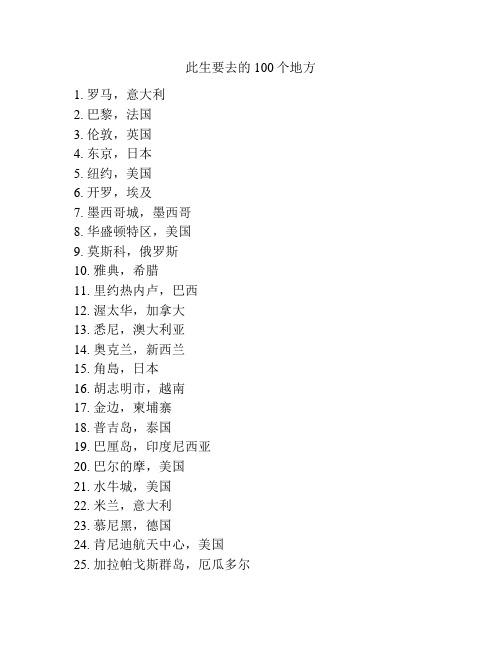
此生要去的100个地方1. 罗马,意大利2. 巴黎,法国3. 伦敦,英国4. 东京,日本5. 纽约,美国6. 开罗,埃及7. 墨西哥城,墨西哥8. 华盛顿特区,美国9. 莫斯科,俄罗斯10. 雅典,希腊11. 里约热内卢,巴西12. 渥太华,加拿大13. 悉尼,澳大利亚14. 奥克兰,新西兰15. 角島,日本16. 胡志明市,越南17. 金边,柬埔寨18. 普吉岛,泰国19. 巴厘岛,印度尼西亚20. 巴尔的摩,美国21. 水牛城,美国22. 米兰,意大利23. 慕尼黑,德国24. 肯尼迪航天中心,美国25. 加拉帕戈斯群岛,厄瓜多尔26. 北海道,日本27. 悉尼,加拿大28. 拉斯维加斯,美国29. 爱丁堡,苏格兰30. 孟买,印度31. 北京,中国32. 德里,印度33. 威尼斯,意大利34. 圣地亚哥,智利35. 夏威夷,美国36. 平壁,美国37. 圣塞巴斯蒂安,西班牙38. 柏林,德国39. 巴塞罗那,西班牙40. 布拉格,捷克41. 多伦多,加拿大42. 温哥华,加拿大43. 科伦坡,斯里兰卡44. 雷克雅未克,冰岛45. 里斯本,葡萄牙46. 南非开普敦47. 悉尼,澳大利亚48. 班加罗尔,印度49. 伊丽莎白港,南非50. 巴拿马城,巴拿马51. 科威特市,科威特52. 圣地亚哥,阿根廷53. 汉堡,德国54. 复活节岛,智利55. 奥兰多,美国56. 盖乌温特,西班牙57. 柏林墙,德国58. 威尼斯海滩,美国59. 开普敦,南非60. 悉尼歌剧院,澳大利亚61. 喜马拉雅山,尼泊尔62. 清迈,泰国63. 尼斯,法国64. 伊斯坦布尔,土耳其65. 里士满,美国66. 哥本哈根,丹麦67. 巴布亚新几内亚68. 北极圈69. 塔吉克斯坦70. 柏林,罗马尼亚71. 布拉格城堡,捷克72. 穆尼赫豪森,德国73. 苏黎世,瑞士74. 华沙,波兰75. 旧金山,美国76. 古巴哈瓦那77. 墨尔本,澳大利亚78. 渥太华,加拿大79. 蒙特利尔,加拿大80. 亚庇,马来西亚81. 厄瓜多尔加拉帕戈斯群岛82. 迪拜,阿联酋83. 亚美尼亚84. 新西兰奥克兰市85. 斯德哥尔摩,瑞典86. 佛罗伦萨,意大利87. 拉巴斯,玻利维亚88. 西雅图,美国89. 达喀尔,塞内加尔90. 云南丽江古城,中国91. 南极洲92. 阿布扎比,阿联酋93. 曼谷,泰国94. 卡利,哥伦比亚95. 马赛古巴塞勒斯港96. 布林迪西,马达加斯加97. 里士满,英国98. 卢萨卡,赞比亚99. 亚眠,法国100. 北约克,英国。
BBC评选出一生必去的50个地方
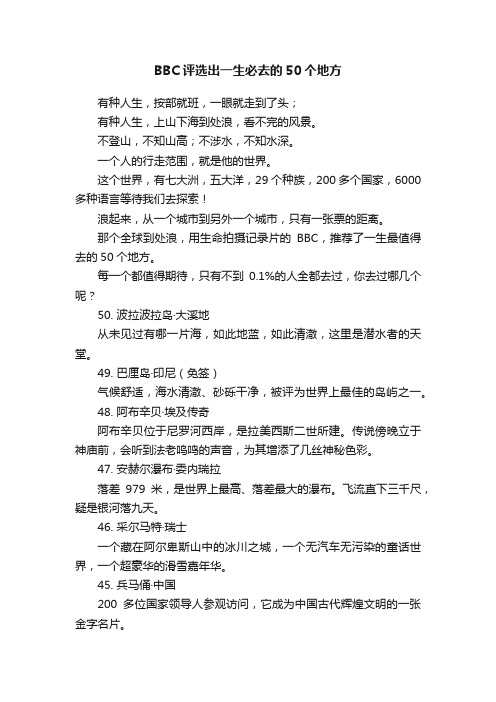
BBC评选出一生必去的50个地方有种人生,按部就班,一眼就走到了头;有种人生,上山下海到处浪,看不完的风景。
不登山,不知山高;不涉水,不知水深。
一个人的行走范围,就是他的世界。
这个世界,有七大洲,五大洋,29个种族,200多个国家,6000多种语言等待我们去探索!浪起来,从一个城市到另外一个城市,只有一张票的距离。
那个全球到处浪,用生命拍摄记录片的BBC,推荐了一生最值得去的50个地方。
每一个都值得期待,只有不到0.1%的人全都去过,你去过哪几个呢?50. 波拉波拉岛·大溪地从未见过有哪一片海,如此地蓝,如此清澈,这里是潜水者的天堂。
49. 巴厘岛·印尼(免签)气候舒适,海水清澈、砂砾干净,被评为世界上最佳的岛屿之一。
48. 阿布辛贝·埃及传奇阿布辛贝位于尼罗河西岸,是拉美西斯二世所建。
传说傍晚立于神庙前,会听到法老呜鸣的声音,为其增添了几丝神秘色彩。
47. 安赫尔瀑布·委内瑞拉落差979米,是世界上最高、落差最大的瀑布。
飞流直下三千尺,疑是银河落九天。
46. 采尔马特·瑞士一个藏在阿尔卑斯山中的冰川之城,一个无汽车无污染的童话世界,一个超豪华的滑雪嘉年华。
45. 兵马俑·中国200多位国家领导人参观访问,它成为中国古代辉煌文明的一张金字名片。
44. 冰岛夏天的太阳永不落幕,冬天的冰雪冰封万里。
它有30多座活火山,是人口密度最低的国家之一。
43. 巴巴多斯·加勒比海以原生态岛屿出名的惊艳小国,每年的夏季丰收节都有一场狂欢。
42. 曼谷·泰国你懂的。
41. 斯里兰卡宝石上的王国,印度洋的一滴泪。
40. 拉迪格岛·塞舌尔岛上人口只有2000个人,却占了一个这么美的地方!39. 新加坡一个在教育、城市建设、福利制度上都非常棒的国家。
我脑子里却冒出了肉骨茶、海南鸡饭、辣椒蟹、叻沙、粿条、咖椰吐司、拉茶……38. 迪拜·阿联酋土豪,土豪,土豪!如果有一天我老无所依,请把我丢在迪拜捡垃圾......37. 巴塞罗那·西班牙这里随处可见毕加索、高迪等大师的杰作,比你能想象的更文艺、更浪漫。
世界著名旅游景点介绍
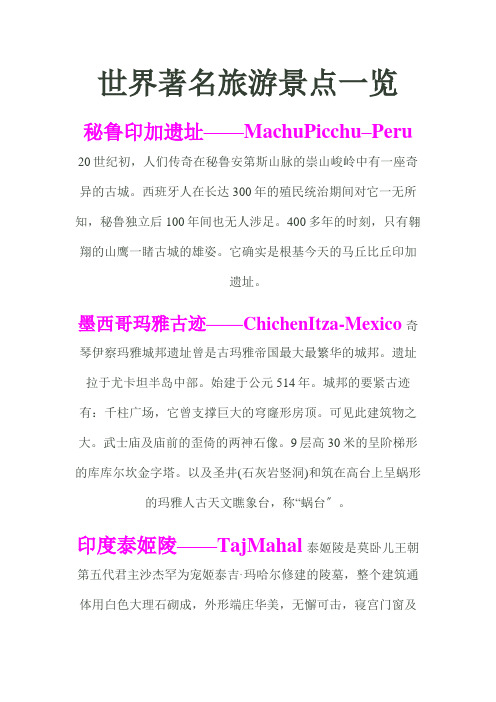
世界著名旅游景点一览秘鲁印加遗址——MachuPicchu–Peru 20世纪初,人们传奇在秘鲁安第斯山脉的崇山峻岭中有一座奇异的古城。
西班牙人在长达300年的殖民统治期间对它一无所知,秘鲁独立后100年间也无人涉足。
400多年的时刻,只有翱翔的山鹰一睹古城的雄姿。
它确实是根基今天的马丘比丘印加遗址。
墨西哥玛雅古迹——ChichenItza-Mexico奇琴伊察玛雅城邦遗址曾是古玛雅帝国最大最繁华的城邦。
遗址拉于尤卡坦半岛中部。
始建于公元514年。
城邦的要紧古迹有:千柱广场,它曾支撑巨大的穹窿形房顶。
可见此建筑物之大。
武士庙及庙前的歪倚的两神石像。
9层高30米的呈阶梯形的库库尔坎金字塔。
以及圣井(石灰岩竖洞)和筑在高台上呈蜗形的玛雅人古天文瞧象台,称“蜗台〞。
印度泰姬陵——TajMahal泰姬陵是莫卧儿王朝第五代君主沙杰罕为宠姬泰吉·玛哈尔修建的陵墓,整个建筑通体用白色大理石砌成,外形端庄华美,无懈可击,寝宫门窗及围屏都用白色大理石镂雕成菱形带花边的小格,墙上用翡翠、水晶、玛瑙、红绿宝石镶嵌着色彩鲜艳的藤蔓花朵,光线所至,光华夺目,明亮有如天上的星辉。
几百年来,不知有多少文人墨客为泰姬陵折腰,写下许多动人的诗篇。
然而当你真正站在她面前时,才会深深体会到,泰姬陵之美,原来是任何文字都无法书写的。
尽代有佳人,遗世而独立。
俏立于亚穆纳河畔那个雪白晶莹、玲珑剔透的身影,秀眉微蹙,要是有所思。
好瞧角——CapeTown非洲西南端的岬角。
1488年葡萄牙航海家迪亚士在寻寻欧洲通向印度的航路时到此,因多风暴,取名风暴角。
但从此通往富庶的东方航道有瞧,故改称好瞧角。
苏伊士运河通航前,来往于亚欧之间的船舶都通过好瞧角。
现特大油轮无法进进苏伊士运河,仍需取此道航行。
好瞧角多暴风雨,海浪汹涌,位于来自印度洋的热和的莫桑比克厄加勒斯洋流和来自南极洲水域的严冷的本格拉洋流的搜集处。
好瞧角正位于大西洋和印度洋的搜集处,强劲的西风急流掀起的惊涛骇浪常年不断,那个地点除风暴为害外,还经常有“杀人浪〞出现。
国家地理评出一生最值得去的50歌地方,今天带你来看看!
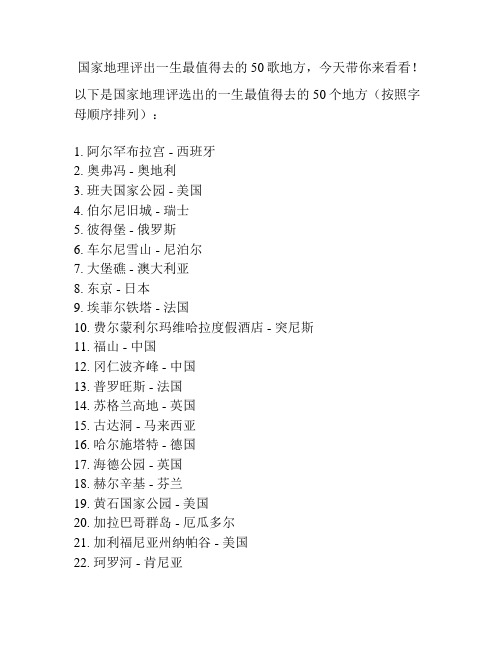
国家地理评出一生最值得去的50歌地方,今天带你来看看!以下是国家地理评选出的一生最值得去的50个地方(按照字母顺序排列):1. 阿尔罕布拉宫 - 西班牙2. 奥弗冯 - 奥地利3. 班夫国家公园 - 美国4. 伯尔尼旧城 - 瑞士5. 彼得堡 - 俄罗斯6. 车尔尼雪山 - 尼泊尔7. 大堡礁 - 澳大利亚8. 东京 - 日本9. 埃菲尔铁塔 - 法国10. 费尔蒙利尔玛维哈拉度假酒店 - 突尼斯11. 福山 - 中国12. 冈仁波齐峰 - 中国13. 普罗旺斯 - 法国14. 苏格兰高地 - 英国15. 古达洞 - 马来西亚16. 哈尔施塔特 - 德国17. 海德公园 - 英国18. 赫尔辛基 - 芬兰19. 黄石国家公园 - 美国20. 加拉巴哥群岛 - 厄瓜多尔21. 加利福尼亚州纳帕谷 - 美国22. 珂罗河 - 肯尼亚23. 拉凡特 - 波利尼西亚24. 兰普德萨佩莱 - 摩洛哥25. 李白故居 - 中国26. 林登 - 瑞士27. 黎巴嫩贝鲁特 - 黎巴嫩28. 罗斯福岛 - 美国29. 马恩河谷 - 法国30. 梅斯老城 - 法国31. 摩丝特罗 - 挪威32. 柏林墙纪念碑 - 德国33. 平遥古城 - 中国34. 乔戈里峰 - 俄罗斯35. 圣布莱泽河 - 南非36. 圣彼得大教堂 - 梵蒂冈37. 圣托里尼岛 - 希腊38. 圣剑修道院 - 英国39. 什里什舍夫斯基国家公园 - 克罗地亚40. 斯特灵城堡 - 英国41. 托斯卡纳 - 意大利42. 瓦哈卡 - 墨西哥43. 威灵顿 - 新西兰44. 乌兹别克斯坦撒马尔罕 - 乌兹别克斯坦45. 西风林地 - 欧洲46. 新德里 - 印度47. 伊色卡湾 - 土耳其48. 伊瓜苏大瀑布 - 阿根廷和巴西49. 约丹国家公园 - 美国50. 罗马 - 意大利这些地方各具特色,涵盖了自然景观、历史文化和人文风情等各个方面,是人们一生必去的旅行目的地。
中国国家地理评选的一生必去的50个地方

中国国家地理评选的一生必去的50个地方
中国国家地理评选的一生必去的50个地方有:
1. 九寨沟
2. 喀纳斯
3. 稻城亚丁
4. 伊犁
5. 阳朔
6. 香格里拉
7. 黄果树瀑布
8. 怒江大峡谷
9. 神农架
10. 呼伦贝尔
11. 壶口瀑布
12. 大兴安岭
13. 喀拉峻草原
14. 长江三峡
15. 阿里
16. 林芝
17. 雅鲁藏布大峡谷
18. 西湖
19. 洱海
20. 西双版纳
21. 婺源
22. 额济纳旗胡杨林
23. 马岭河大峡谷
24. 乌兰布统大草原
25. 黄山
26. 张家界国家森林公园
27. 长白山景区
28. 普者黑景区
29. 荔波小七孔景区
30. 乌镇西栅景区
31. 华顶国家森林公园
32. 大理古城
33. 三清山风景区玉京峰景区
34. 天山天池景区
35. 普陀山风景区
36. 南迦巴瓦峰景区
37. 四姑娘山景区
38. 白公山景区
39. 涠洲岛火山地质公园鳄鱼山景区
40. 天鹅湖景区
41. 巴音布鲁克景区
42. 黄龙景区
43. 大瑶山风景名胜区-西山弄景区(金秀瑶族博物馆)
44. 大瑶山风景名胜区-莲花山景区(蒙宝千亩金银花基地)
45. 大瑶山风景名胜区-老虎潭峡谷漂流景区(老虎潭峡谷)
46. 大瑶山风景名胜区-莲花山景区(蒙宝千亩金银花基地)
47. 袁家界景区
48. 青城山
49. 都江堰
50. 大山铺。
墨西哥尤卡坦州玛雅文明的遗址
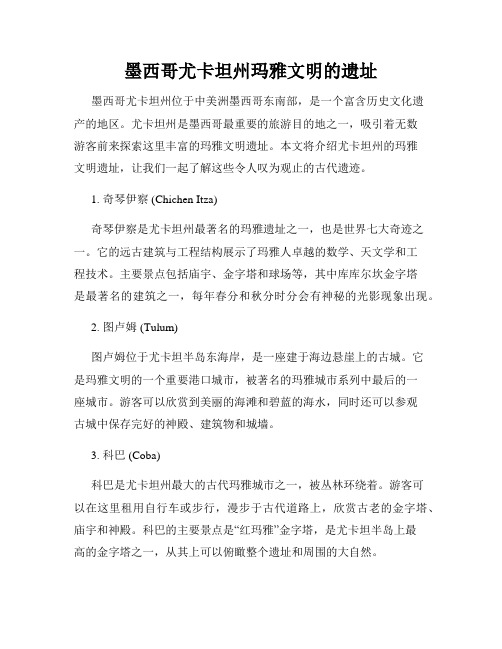
墨西哥尤卡坦州玛雅文明的遗址墨西哥尤卡坦州位于中美洲墨西哥东南部,是一个富含历史文化遗产的地区。
尤卡坦州是墨西哥最重要的旅游目的地之一,吸引着无数游客前来探索这里丰富的玛雅文明遗址。
本文将介绍尤卡坦州的玛雅文明遗址,让我们一起了解这些令人叹为观止的古代遗迹。
1. 奇琴伊察 (Chichen Itza)奇琴伊察是尤卡坦州最著名的玛雅遗址之一,也是世界七大奇迹之一。
它的远古建筑与工程结构展示了玛雅人卓越的数学、天文学和工程技术。
主要景点包括庙宇、金字塔和球场等,其中库库尔坎金字塔是最著名的建筑之一,每年春分和秋分时分会有神秘的光影现象出现。
2. 图卢姆 (Tulum)图卢姆位于尤卡坦半岛东海岸,是一座建于海边悬崖上的古城。
它是玛雅文明的一个重要港口城市,被著名的玛雅城市系列中最后的一座城市。
游客可以欣赏到美丽的海滩和碧蓝的海水,同时还可以参观古城中保存完好的神殿、建筑物和城墙。
3. 科巴 (Coba)科巴是尤卡坦州最大的古代玛雅城市之一,被丛林环绕着。
游客可以在这里租用自行车或步行,漫步于古代道路上,欣赏古老的金字塔、庙宇和神殿。
科巴的主要景点是“红玛雅”金字塔,是尤卡坦半岛上最高的金字塔之一,从其上可以俯瞰整个遗址和周围的大自然。
4. 坦波 (TAMPUH)坦波是一个隐匿在丛林和湖泊中的古代玛雅遗址。
这里的建筑物大多数是石制的,呈现出精美的雕刻和建筑技巧。
游客可以在坦波遗址中欣赏到巨大的神庙、宫殿和观测塔,还可以在湖中划船,享受宁静的自然环境。
5. 盖拉德 (Uxmal)盖拉德是尤卡坦州最重要的玛雅遗址之一,也是被联合国教科文组织列为世界遗产的地方。
它以其华丽的建筑和复杂的雕刻而闻名,特别是最大的建筑物比隆金字塔。
在这里,游客可以欣赏到玛雅文明的鼎盛时期的瑰宝,了解玛雅文化的精髓所在。
尤卡坦州的玛雅文明遗址是世界上最重要的古代文明遗产之一。
这些古老的建筑和文化遗迹,让我们有机会了解和欣赏到玛雅人的智慧、技术和对自然的崇拜。
人生梦想 50个旅游目的地清单

1.罗马,意大利
2.帕里斯,法国
3.尼亚加拉瀑布,加拿大/美国
4.金字塔,埃及
5.悉尼歌剧院,澳大利亚
6.雅典,希腊
7.巴厘岛,印度尼西亚
8.乞力马扎罗山,坦桑尼亚
9.雪松森林,黎巴嫩
10.纳帕谷,美国
11.雅典娜神庙,希腊
12.圣托里尼,希腊
13.北极圈,北极
14.拉斯维加斯,美国
15.喜马拉雅山脉,尼泊尔/印度
16.大堡礁,澳大利亚
17.石垣岛,日本
18.夏威夷,美国
19.阿姆斯特丹,荷兰
20.雅典卫城,希腊
21.纽约市,美国
22.威尼斯,意大利
23.大峡谷,美国
24.拉普兰,芬兰
25.马丘比丘,秘鲁
26.巴黎圣母院,法国
27.肯尼亚大草原,肯尼亚
28.大本钟,英国
29.悉尼塔,澳大利亚
30.圣彼得大教堂,梵蒂冈
31.雅典卫城博物馆,希腊
32.爱尔兰乡村,爱尔兰
33.洛杉矶,美国
34.雅典奥林匹克体育场,希腊
35.拉普兰秋季北极光,芬兰
36.罗马竞技场,意大利
37.亚马逊雨林,巴西
38.荷兰风车村,荷兰
39.奥克兰,新西兰
40.雅典国家考古博物馆,希腊
41.加拉帕戈斯群岛,厄瓜多尔
42.雅典国家花园,希腊
43.罗马圆形竞技场,意大利
44.南非草原,南非
45.蒙特卡洛,摩纳哥
46.越南河内,越南
47.罗马教皇宫,梵蒂冈
48.罗马卡斯特罗广场,意大利
49.埃菲尔铁塔,法国
50.夏威夷火山国家公园,美国。
遍赏人生必不可错过的50个城市

遍赏人生必不可错过的50个城市人生只有短短的3万多天,每当开始新的一年,新的一天,你的旅行日程就会更新,不断改变的计划可能会让很多“潜力股”旅游景点在你的手中滑过,财富派为您推荐不可错过的50座必到城市,这样的人生才完美!美洲:1、美国旧金山,推荐理由:美国西部之星的旧金山有着历史性的建筑,天然无瑕疵的公园及广受欢迎的美食。
2、美国拉斯维加斯,推荐理由:“万恶之城”拥有无可匹敌的豪华酒店,奢侈餐厅及酒醉灯迷的赌场娱乐场。
3、美国纽约,推荐理由:作为“世界十字路口”,它绝对不是浪得虚名:让人身心沉迷的艺术,丰富多元的文化,充满竞争的商界,但是也不乏独特地道的美食。
4、巴西里约热内卢,推荐理由:除了家喻户晓的狂欢节,这里拥有两片世界著名的海滩,巴西之旅便是视觉、听觉、感觉、嗅觉、味觉盛宴。
5、古巴哈瓦那,推荐理由:在古老的哈瓦那城闲游,似乎回到了革命前的时代:庄严肃穆的建筑,复古典雅的轿车,还有和煦的海风轻抚着你享用美食时惬意的脸庞。
6、秘鲁库斯科,推荐理由:探索安第斯山脉和马丘比丘古城必须从这里进入,寻找历史寺庙,修道院及殖民者的房屋必须在这个世界遗产的城市开始。
7、哥伦比亚卡塔赫纳,推荐理由:探险家、海盗、皇族都曾在这个加勒比海岸的殖民城市留下印记。
8、危地马拉安地瓜,推荐理由:在三座备受瞩目的火山下,安地瓜只有“神奇”这个词可以形容。
殖民时代的教堂,修道院遗址是历史的见证,波西米亚风的咖啡馆是现代的标志。
9、阿根廷布宜诺斯艾利斯,推荐理由:这里被称为“南美洲巴黎”,享受生活就要到布宜诺斯艾利斯漫步林荫道,居住在缤纷房屋里,参加探戈俱乐部。
布宜诺斯艾利斯的博卡区以彩色建筑而闻名,七彩的铁皮屋连成一幅巨大的调色板,各种斑斓的色调在建筑物上混搭,整个博卡区就像是一条美艳的彩虹。
同时,这里也是探戈的故乡,街边经常可以看到男男女女即兴表演。
10、墨西哥城,推荐理由:2亿人口的墨西哥城是景色、天籁和色彩的交织,殖民时期的建筑及遗址更让其充满历史的沉重感。
美国国家地理杂志选出的五十个人生必去的地方

美国国家地理杂志选出的五十个“真正的旅人此生必游之地”都市(不朽之城)1.香港(Hong Kong)2.伦敦(London):古老的英国还有苏格兰的城堡和风笛3.纽约(New York)4.巴黎(Paris):卢浮宫和奥罗博物馆,梵高的画……5.旧金山(San Francisco)6.威尼斯(Venice):威尼斯的水乡和狂欢节7.巴塞罗纳(Barcelona):去西班牙一定去的地方8.里约热内卢(Rio de Janeiro):南美,实在是美丽但太遥远的地方9.伊斯坦堡(Istanbul):不会刻意去的国度10.耶路撒冷(Jerusalem):一直好奇这么个3大宗教的圣城魅力何在?可惜战乱纷飞自然景观(伊甸园的最后要塞)1.大峡谷(The Grand Canyon)2.南极洲(Antarctica):看了马莉到南北极的游记,这里太遥远花费也高。
3.亚马逊丛林(Amazon) :蛇和鳄鱼,食人族和毒箭……4.加拿大洛矶山脉(Canadian Rockies)5.厄瓜多尔的加拉巴哥群岛(Galapagos Islands)6.澳洲内陆(Australian Outback)7.巴布亚纽几内亚的珊瑚礁(Papua New Guinea Reefs)8.撒哈拉沙漠(Sahara):提起这里就会想起三毛9.坦桑尼亚的塞伦盖提平原(Serengeti):7、8月去看众多动物迁徙的盛况10.委内瑞拉的德布伊斯高原(Venezuela's Tepuis):很美人间乐土(安宁、美丽、天赐愉悦)1.英属维京群岛(British Virgin Islands)2.意大利的阿玛菲海岸(Amalfi Coast)3.明尼苏达州边界水域(Boundary Waters)4.希腊小岛(Greek Islands) :爱琴海,怎么可能不向往5.夏威夷群岛(Hawaiian Islands):极致的海岛6.日本民宿(Japanese Ryokan):对中国来说,那种文化冲击不算大7.印度喀拉拉邦(Kerala)8.智利托雷德裴恩国家公园(Torres del Paine)9.印度洋的塞昔尔群岛(Seychelles):在天涯上看过一个叫回首自纤纤的帖子,很美10.太平洋岛屿(Pacific Islands)乡野景观(文明与自然并存)1.加州大索尔(Big Sur)2.意大利托斯卡纳(Tuscany)3.阿尔卑斯山(Alps):中国的四姑娘山号称东方阿尔卑斯4.挪威海岸(Coastal Norway):风格迥然的海滨,号称最美的挪威海湾5.英格兰湖区(England's Lake District):无数多英文小说里面提到的度假地6.法国罗亚尔河谷(Loire Valley)7.美国佛蒙特州(Vermont)8.加拿大滨海诸省(Canadian Maritimes)9.越南蚬港至顺化(Danang to Hue)10.纽西兰北岛(North Island, New Zealand) :魔戒过后,很多人梦想去这个地方世界奇景(人类伟大建设)1.长城(Great Wall)2.梵蒂冈(Vatican City):罗马假日3.计算机领域(Cyberspace):有了电脑和网络,人生多了多少乐趣。
2024届四川省成都高三零诊模拟考试英语试题含解析
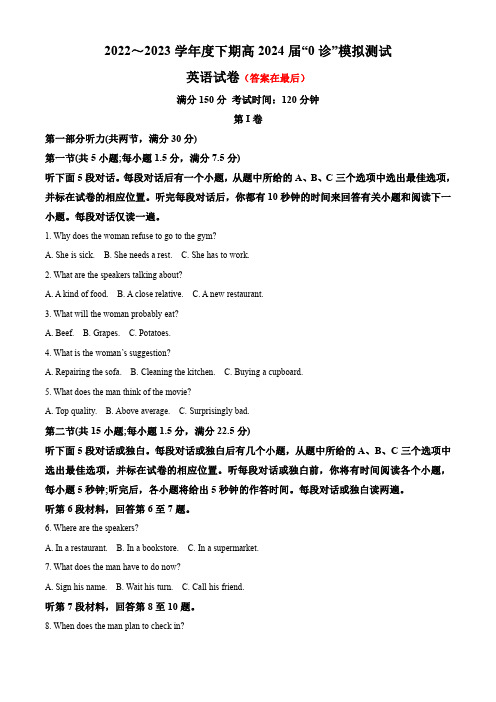
2022~2023学年度下期高2024届“0诊”模拟测试英语试卷(答案在最后)满分150分考试时间:120分钟第I卷第一部分听力(共两节,满分30分)第一节(共5小题;每小题1.5分,满分7.5分)听下面5段对话。
每段对话后有一个小题,从题中所给的A、B、C三个选项中选出最佳选项,并标在试卷的相应位置。
听完每段对话后,你都有10秒钟的时间来回答有关小题和阅读下一小题。
每段对话仅读一遍。
1.Why does the woman refuse to go to the gym?A.She is sick.B.She needs a rest.C.She has to work.2.What are the speakers talking about?A.A kind of food.B.A close relative.C.A new restaurant.3.What will the woman probably eat?A.Beef.B.Grapes.C.Potatoes.4.What is the woman’s suggestion?A.Repairing the sofa.B.Cleaning the kitchen.C.Buying a cupboard.5.What does the man think of the movie?A.Top quality.B.Above average.C.Surprisingly bad.第二节(共15小题;每小题1.5分,满分22.5分)听下面5段对话或独白。
每段对话或独白后有几个小题,从题中所给的A、B、C三个选项中选出最佳选项,并标在试卷的相应位置。
听每段对话或独白前,你将有时间阅读各个小题,每小题5秒钟;听完后,各小题将给出5秒钟的作答时间。
每段对话或独白读两遍。
听第6段材料,回答第6至7题。
6.Where are the speakers?A.In a restaurant.B.In a bookstore.C.In a supermarket.7.What does the man have to do now?A.Sign his name.B.Wait his turn.C.Call his friend.听第7段材料,回答第8至10题。
一生中应该去的50个景点
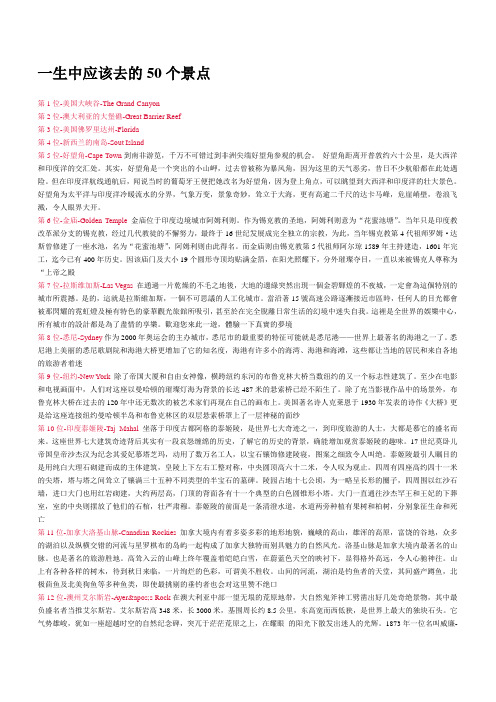
一生中应该去的50个景点第1位-美国大峡谷-The Grand Canyon第2位-澳大利亚的大堡礁-Great Barrier Reef第3位-美国佛罗里达州-Florida第4位-新西兰的南岛-Sout Island第5位-好望角-Cape Town到南非游览,千万不可错过到非洲尖端好望角参观的机会。
好望角距离开普敦约六十公里,是大西洋和印度洋的交汇处。
其实,好望角是一个突出的小山岬,过去曾被称为暴风角,因为这里的天气恶劣,昔日不少航船都在此处遇险。
但在印度洋航线通航后,闻说当时的葡萄牙王便把她改名为好望角,因为登上角点,可以眺望到大西洋和印度洋的壮大景色。
好望角为太平洋与印度洋冷暖流水的分界,气象万变,景象奇妙,耸立于大海,更有高逾二千尺的达卡马峰,危崖峭壁,卷浪飞溅,令人眼界大开。
第6位-金庙-Golden Temple 金庙位于印度边境城市阿姆利则。
作为锡克教的圣地,阿姆利则意为“花蜜池塘”。
当年只是印度教改革派分支的锡克教,经过几代教徒的不懈努力,最终于16世纪发展成完全独立的宗教,为此,当年锡克教第4代祖师罗姆·达斯曾修建了一座水池,名为“花蜜池塘”,阿姆利则由此得名。
而金庙则由锡克教第5代祖师阿尔琼1589年主持建造,1601年完工,迄今已有400年历史。
因该庙门及大小19个圆形寺顶均贴满金箔,在阳光照耀下,分外璀璨夺目,一直以来被锡克人尊称为“上帝之殿第7位-拉斯维加斯-Las Vegas 在通過一片乾燥的不毛之地後,大地的邊緣突然出現一個金碧輝煌的不夜城,一定會為這個特別的城市所震撼。
是的,這就是拉斯維加斯,一個不可思議的人工化城市。
當沿著15號高速公路逐漸接近市區時,任何人的目光都會被那閃耀的霓虹燈及極有特色的豪華觀光旅館所吸引,甚至於在完全脫離日常生活的幻境中迷失自我。
這裡是全世界的娛樂中心,所有城市的設計都是為了盡情的享樂。
歡迎您來此一遊,體驗一下真實的夢境第8位-悉尼-Sydney作为2000年奥运会的主办城市,悉尼市的最重要的特征可能就是悉尼港——世界上最著名的海港之一了。
介绍墨西哥景点英文作文

介绍墨西哥景点英文作文英文:Mexico is a beautiful country with many amazing tourist attractions. As someone who has visited Mexico several times, I can say that there are so many places to see and things to do that it's hard to choose just a few. However, here are some of my favorite Mexican tourist attractions:1. Chichen Itza: This ancient Mayan city is one of the most famous archaeological sites in Mexico. It is home to the iconic El Castillo pyramid, as well as several other impressive ruins. The site is also a UNESCO World Heritage site.2. Cancun: This popular beach destination is known for its crystal-clear waters and white sand beaches. It's a great place to relax and soak up the sun, but there are also plenty of activities to do, such as snorkeling, parasailing, and jet skiing.3. Mexico City: The capital city of Mexico is a vibrant and bustling metropolis with a rich history and culture. There are many museums and landmarks to visit, such as the National Museum of Anthropology and the Palacio de Bellas Artes.4. Tulum: This coastal town is known for its stunning beaches and well-preserved Mayan ruins. It's a great placeto go if you want to combine history and relaxation.中文:墨西哥是一个美丽的国家,有许多惊人的旅游景点。
国家地理评出一生最值得去的50歌地方,今天带你来看看!

国家地理评出一生最值得去的50歌地方,今天带你来看看!1. 大峡谷国家公园,美国2. 太阳神之城马丘比丘,秘鲁3. 瓦胡岛,夏威夷4. 亚马逊雨林,巴西5. 大堡礁,澳大利亚6. 奇琴伊察遗址,墨西哥7. 埃菲尔铁塔,法国8. 加拉帕戈斯群岛,厄瓜多尔9. 纳米布沙漠,纳米比亚10. 乞力马扎罗山,坦桑尼亚11. 白川乡合掌村,日本12. 圣彼得堡,俄罗斯13. 纽约市花园大道,美国14. 斯基达德尔,冰岛15. 雅尔塔,克里米亚16. 克拉科夫旅游景点,波兰17. 坎昆,墨西哥18. 悉尼歌剧院,澳大利亚19. 罗马竞技场,意大利20. 雅典卫城,希腊21. 吴哥窟,柬埔寨22. 斯科普里,马其顿23. 拉斯维加斯,美国24. 南非克鲁格国家公园25. 阿姆斯特丹,荷兰26. 威尼斯,意大利27. 罗浮宫,法国28. 悉尼港大桥,澳大利亚29. 加尔各答,印度30. 埃及金字塔,埃及31. 阿布扎比,阿联酋32. 雪村,日本33. 里约热内卢,巴西34. 贝尔格莱德,塞尔维亚35. 南极洲旅游景点36. 危地马拉市-天鹅湖-危地马拉市环行线,瓜地马拉37. 巴塞罗那,西班牙38. 塞舌尔群岛39. 千本鹤、伏見稻荷、银阁寺,京都,日本40. 曼谷,泰国41. 南非喀麦隆湾国家公园42. 开普敦,南非43. 凡尔登战役纪念碑,法国44. 马尔代夫度假村45. 北极旅游景点46. 阿拉斯加邮轮47. 悉尼塔罗宾逊大厦,澳大利亚48. 阿姆斯特丹花卉市场,荷兰49. 四川九寨沟50. 卡利马哈山,夏威夷美国。
Chichen Itza 奇琴伊察
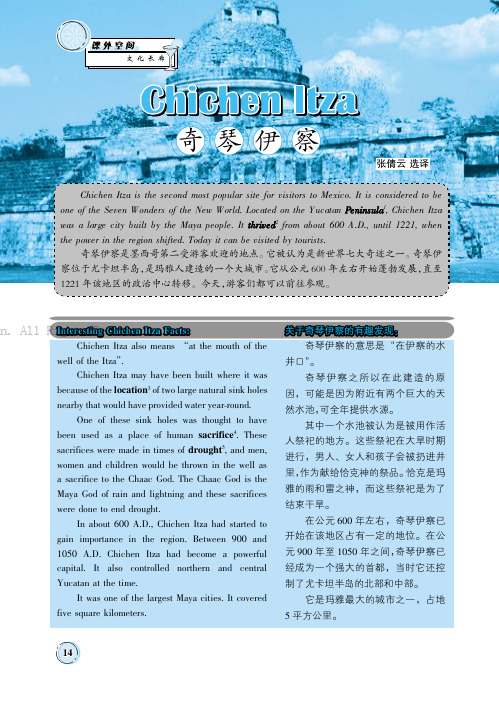
文化长廊奇琴伊察张倩云选译14美文【Notes 】1.peninsula [].半岛 2.thrive []繁荣,兴旺3.location [].位置;地点 4.sacrifice []牺牲;祭品5.drought [].干旱 6.religious []宗教的7.pilgrimage [].漫游;朝圣之行8.architectural []建筑上的9.monument []纪念碑;历史遗迹10.spark []点燃;导致;引发11.exploration [].探测;探索Chichen Itza may have been a religious 6center for a period of time and is believed to have been a pilgrimage 7place for the Maya.Some suggest that the site where Chichen Itza was built was already a popular place of pilgrimage long before building of the city ever began.There is a wide variety of architectural 8styles because of the fact that Chichen Itza had such diverse population and culture.All the buildings of Chichen Itza are made of stone.It ’s also thought that the Maya did no use the wheel to build any of their temples,pyramids or palaces.Some of the most famous buildings in Chichen Itza that have survived include:The Warrior ’s Temple,El Castillo,and The Great Ball Court.El Castillo is probably the most famous image of Chichen Itza.It is a monument 9in the shape of a pyramid.There are four staircases on the outside of the pyramid.Part of what sparked 10an interest in Chichen Itza was a book (travel journal)written by John Lloyd Stephens in 1843called .Further exploration 11of the city began from the interest and imagination of his readers.About 1.2million people visit the ruins of Chichen Itza every year.奇琴伊察可能在一段时间里是宗教中心,它被认为是玛雅人朝圣的地方。
- 1、下载文档前请自行甄别文档内容的完整性,平台不提供额外的编辑、内容补充、找答案等附加服务。
- 2、"仅部分预览"的文档,不可在线预览部分如存在完整性等问题,可反馈申请退款(可完整预览的文档不适用该条件!)。
- 3、如文档侵犯您的权益,请联系客服反馈,我们会尽快为您处理(人工客服工作时间:9:00-18:30)。
骷髅平台(tzompantli) 骷髅平台位于武士神庙的东侧, 是长60米、宽15米的建筑,其侧 壁上刻满骷髅,可能是陈列被献 祭者首级之处。
The Skull Platform shows the clear cultural influence of the central Mexican Plateau( [plæ‘to] adj. 高原印第安人 的). Unlike the tzompantli of the highlands, however, the skulls were impaled ve r t i c a l l y rat h e r t h a n horizontally ([,hɑrə’zɑntli] adv. 水 平地)as at Tenochtitlan(特诺 奇 蒂 特 兰 城 ) .
all run underground. There are two large, natural sink holes, called cenotes [si'nəuti] n. 天然井), that could have provided plentiful water year round at Chichen , making it attractive for settlement. Of the two cenotes , the
Las Monjas is one of the more notable ( adj. 值 得 注 意 的 ; 显 著 的 ) structures at Chichen Itza. It is a complex of Terminal Classic( 古 典 时 期)buildings constructed in the Puuc architectural( 普 克 建 筑 ) style. The Spanish named this complex Las Monjas ( “The Nunnery”) but it was actually a governmental palace. Just to the east is a small temple (known as the La Iglesia, “The Church”) decorated with elaborate( [ɪ‘læbərət] adj. 精美的) masks.
圣井,也称祭井,由一条274米长,高于地面的石子路连接。这口深达23米的天然井为当地人 提供饮用水,被作为朝圣之地。 玛雅人对雨神极为崇拜,每到春季都要举行盛大的祭献仪式。每当祭献,国王都要将挑选出来 的一名14 岁的美丽少女投入这口通往“雨神宫殿”的圣井,让她去做雨神的新娘子,向雨神乞 求风调雨顺。在献美女的同时,祭司和贵族们也把各种黄金珠宝投入圣井,以示诚意。那些在 井中数小时后仍存活的人则被救起,并受到礼遇,他们被认为已与雨神交谈过了。
“修女院”北面是一个方形大 平台上的圆形建筑——“椭圆 形天文台” ,又名“蜗牛”, 得名于圆形建筑内部螺旋状的 石头阶梯。天文台是为掌管风 和学习的羽蛇神而设,门设在 可以观察春季昼夜平分点、月 亮最大南北倾斜及其他天文现 象的位置。玛雅人用太阳照射 在门上在屋内形成的阴影来判 断夏至与冬至的到来。在建筑 的边缘放着很大的石头杯子, 玛雅人在里面装上水并通过反 射来观察星宿,以确定他们相 当复杂且极为精确的日历系统。
The Temple of the Warriors complex consists of a large stepped pyramid( [‘pɪrəmɪd] n. 金字塔) fronted and flanked ([flæŋk] vi. 侧面与…相接) by rows of carved columns([’kɒləm] n.圆 柱,柱形物)depicting(vt. [dɪ‘pɪkt]描述) warriors. This complex is analogous ([ə’næləgəs] adj. 类似的)to Temple B at the Toltec ( [‘tɔltek] adj. 托尔特克人的)capital of Tulan, and indicates some form of cultural contact between the two regions. The one at Chichen Itza, however, was constructed on a larger scale. At the top of the stairway on that is a Chac Mool.
The Cenote Sagrado was a place of pilgrimage ([‘pɪlgrɪmɪdʒ] n. 朝圣之行)for ancient Maya people who, according to ethnohistoric([,eθnəu-his’tɔrik] adj. 人种史学的) sources, would conduct sacrifices during times of drought. Archaeological investigations support this as thousands of objects have been removed from the bottom of the cenote, including material such as gold, carved jade, copal([‘kəʊp(ə)l] n. 柯巴脂), pottery ([‘pɒt(ə)rɪ] n. 陶器), flint([flɪnt] n. 打火石), obsidian([əb’sɪdɪən] n. 黑曜 石), rubber, cloth, as well as skeletons(['skɛlətn] n. 骷髅) of children and men.
Chichen Itza
state in Mexico . The northern Yucatán Peninsula [ pə'nɪnsələ ] n. 半
岛
is arid['æ rɪd ] adj. 干旱的; [农] 荒芜的 , and the rivers in the interior
( [ɪn‘tɪɜːrɪə] n. 内部;本质adj. 内部的; 国内的;本质的)
奇琴伊察最令人注目的古 典时期建筑之一是一组精 美的普克风格建筑群。虽 然被西班牙人起了"修女 院"("Las Monjas","The Nunnery")的绰号,这组 建筑实际上是城市在古典 时期的政府宫殿。东边不 远是一座不大的庙宇,绰 号“教堂”(La Iglesia, The Church),装饰有精 美的雨神面具。 “修女院”建筑群附近还 有一些其他建筑,包括: Akab‘ Dzib (玛雅语“黑 暗或朦胧的文字”),有 着象形文字铭文的宫殿; “红房子”“鹿房子”
Why the shape of other platforms are rectangular?
In keeping with Maya practice
球 场 Archaeologists have identified 13 ballcourts for playing the Mesoamerican(中美洲)ballgame in Chichen Itza,but the Great Ball Court about 150 metres to the north-west of the Castillo is by far the most impressive. It is the largest and best preserved ball court in ancient Mesoamerica. The parallel platforms flanking the main playing area are each 95 metres long. The walls of these platforms stand 8 metres high; set high up in the centre of each of these walls are rings carved with intertwined feathered serpents(['sɜːp(ə)nt] n.
Chichen Itza, Mexico
Pre-Hispanic City of Chichen-Itza
[ hi'spæ nik ]
adj. 西班牙的
墨
西
哥
பைடு நூலகம்
玛
雅
古
迹
Chichen Itza is located in the eastern portion of Yucatán
([ju:kə‘ta:n] 尤卡坦州(位于墨西哥)
TheYucatán Peninsula is a limestone([‘laɪmstəʊn] n. [岩] 石灰岩) plain, with no rivers or streams. The region is pockmarked(有凹痕的) with natural sinkholes, called cenotes, which expose the water table to the surface. One of the most impressive of these is the Cenote Sagrado, which is 60 metres in diameter(n. 直径), and sheer cliffs(陡峭的悬崖) that drop to the water table some 27 metres below.
奇琴伊察的武士庙,建有1000根圆柱,被称为“千柱厅”。比起玛雅人早先建造的那些古 城,奇琴伊察的建筑虽然稍晚,但别具特色,也可以说,这座举世闻名的武士庙是当时世 界上最为超前的杰作。该庙建于公元11世纪,以内部占地广阔著称。穹窿形的石房顶用木 楣支持,木楣则置放在石柱之上。现在,房顶和木楣都已不见,只有石柱石墙仍然留存。 武士庙刻有极其丰富的浮雕装饰。大门上有两根纤细的蛇形柱,蛇头雕刻精美,两边墙面 雕有龙头蛇身图案浮雕,梯道两边的顶端立有武士小雕像,在武士庙中通到圣殿的阶梯顶 上,有座称为“查克穆尔”的人像。考古发现,托尔特克人在尤卡坦半岛,留下许多这种 石刻人像。而当时奇琴伊察的祭师,可能把活人祭品的心脏摆在这个斜倚的人像上.
